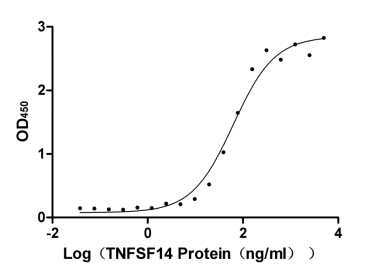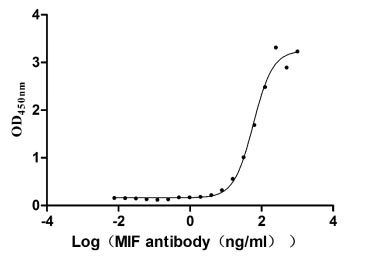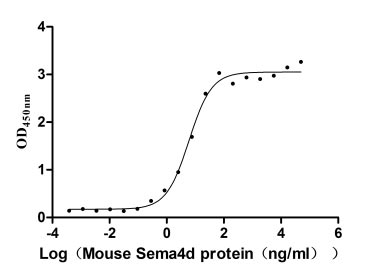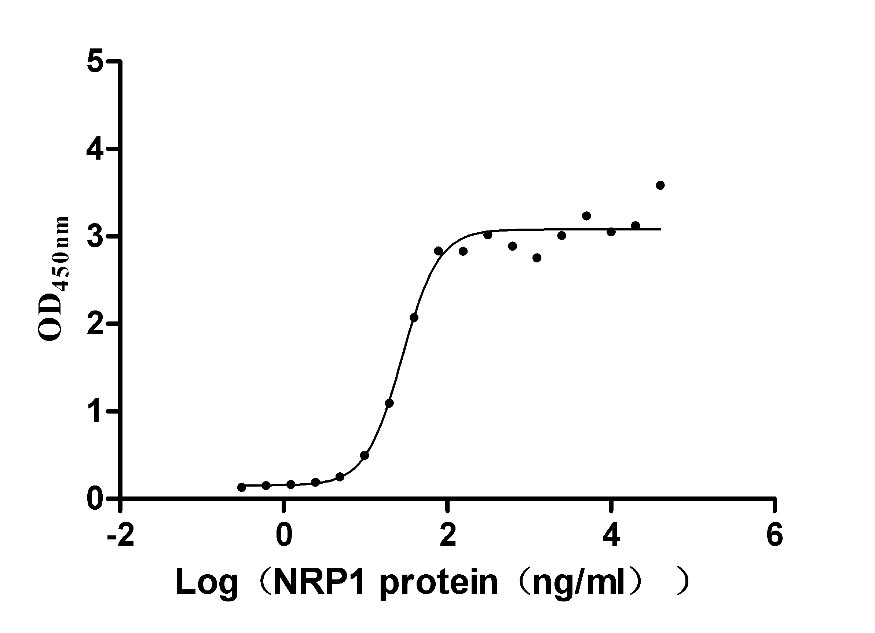Recombinant Human Basement membrane-specific heparan sulfate proteoglycan core protein (HSPG2), partial
-
货号:CSB-YP010868HU
-
规格:
-
来源:Yeast
-
其他:
-
货号:CSB-EP010868HU-B
-
规格:
-
来源:E.coli
-
共轭:Avi-tag Biotinylated
E. coli biotin ligase (BirA) is highly specific in covalently attaching biotin to the 15 amino acid AviTag peptide. This recombinant protein was biotinylated in vivo by AviTag-BirA technology, which method is BriA catalyzes amide linkage between the biotin and the specific lysine of the AviTag.
-
其他:
产品详情
-
纯度:>85% (SDS-PAGE)
-
基因名:HSPG2
-
Uniprot No.:
-
别名:Basement membrane specific heparan sulfate proteoglycan core protein; Endorepellin (domain V region); Heparan sulfate proteoglycan of basement membrane; HSPG 2; HSPG; Hspg2; LG3 peptide; Perlecan; PGBM_HUMAN; PLC; Schwartz Jampel syndrome 1 (chondrodystrophic myotonia); SJA; SJS; SJS1
-
种属:Homo sapiens (Human)
-
蛋白长度:Partial
-
蛋白标签:Tag type will be determined during the manufacturing process.
The tag type will be determined during production process. If you have specified tag type, please tell us and we will develop the specified tag preferentially. -
产品提供形式:Lyophilized powder
Note: We will preferentially ship the format that we have in stock, however, if you have any special requirement for the format, please remark your requirement when placing the order, we will prepare according to your demand. -
复溶:We recommend that this vial be briefly centrifuged prior to opening to bring the contents to the bottom. Please reconstitute protein in deionized sterile water to a concentration of 0.1-1.0 mg/mL.We recommend to add 5-50% of glycerol (final concentration) and aliquot for long-term storage at -20℃/-80℃. Our default final concentration of glycerol is 50%. Customers could use it as reference.
-
储存条件:Store at -20°C/-80°C upon receipt, aliquoting is necessary for mutiple use. Avoid repeated freeze-thaw cycles.
-
保质期:The shelf life is related to many factors, storage state, buffer ingredients, storage temperature and the stability of the protein itself.
Generally, the shelf life of liquid form is 6 months at -20°C/-80°C. The shelf life of lyophilized form is 12 months at -20°C/-80°C. -
货期:Delivery time may differ from different purchasing way or location, please kindly consult your local distributors for specific delivery time.Note: All of our proteins are default shipped with normal blue ice packs, if you request to ship with dry ice, please communicate with us in advance and extra fees will be charged.
-
注意事项:Repeated freezing and thawing is not recommended. Store working aliquots at 4°C for up to one week.
-
Datasheet :Please contact us to get it.
相关产品
靶点详情
-
功能:Integral component of basement membranes. Component of the glomerular basement membrane (GBM), responsible for the fixed negative electrostatic membrane charge, and which provides a barrier which is both size- and charge-selective. It serves as an attachment substrate for cells. Plays essential roles in vascularization. Critical for normal heart development and for regulating the vascular response to injury. Also required for avascular cartilage development.; Endorepellin in an anti-angiogenic and anti-tumor peptide that inhibits endothelial cell migration, collagen-induced endothelial tube morphogenesis and blood vessel growth in the chorioallantoic membrane. Blocks endothelial cell adhesion to fibronectin and type I collagen. Anti-tumor agent in neovascularization. Interaction with its ligand, integrin alpha2/beta1, is required for the anti-angiogenic properties. Evokes a reduction in phosphorylation of receptor tyrosine kinases via alpha2/beta1 integrin-mediated activation of the tyrosine phosphatase, PTPN6.; The LG3 peptide has anti-angiogenic properties that require binding of calcium ions for full activity.
-
基因功能参考文献:
- Molecular analysis results revealed a novel homozygous variant in the HSPG2 gene (MIM 142461), NM_005529.6(HSPG2):c.4029 + 1G>A, consistent with a diagnosis of Dyssegmental dysplasia, Silverman-Handmaker type. PMID: 29526034
- The results of the present study suggested that the compound heterozygous mutations in HSPG2 may be responsible the induction of Schwartz-Jampel syndrome type 1 (SJS1), and demonstrated the genotypephenotype associations between mutations in the HSPG2 gene and clinical characteristics of SJS1 PMID: 29901129
- The differential immunoexpression of perlecan and biglycan in these types of ameloblastomas suggests their participation in the developmental process of these tumors. PMID: 29921372
- The Mechanistic studies showed that CSPG4 bound to perlecan via hydrophobic protein-protein interactions involving multiple sites on perlecan including the C-terminal region. PMID: 29462330
- The results indicate that increase of heparan sulfate content and up-regulation of perlecan/HSPG2 expression in glioblastoma tissues contribute to tumour development through the transformation of brain extracellular matrix into tumour microenvironment, and represent negative prognostic factors for glioblastoma progression. PMID: 29322326
- Mutations in this gene are responsible for the allelic Skeletal Dysplasias Schwartz-Jampel syndrome type 1 and the Silverman-Handmaker type of Dyssegmental Dysplasia, both of which are autosomal recessive. PMID: 28570402
- Perlecan functions in autophagy and angiogenesis where its proangiogenesis activity is counteracted by endorepellin, the C-terminal fragment of perlecan, in these cellular and morphogenic events. (Review) PMID: 27613501
- We found that perlecan expression decreased during chronological skin aging. Our in vitro studies revealed reduced perlecan transcript levels in aged keratinocytes. Perlecan down-regulation in cultured keratinocytes caused depletion of the cell population that expressed keratin 15.Finally, we found defects in keratin 15 expression in the epidermis of aging skin. PMID: 26996820
- Putative stem cell populations associated with hair bulbs, humeral perichondrium, humeral and ulnar rudiment stromal/perivascular tissues expressed the Chondroitin sulfate motifs 4C3, 7D4, and 3B3[-] along with perlecan in close association but not colocalized. PMID: 27068010
- autophagy is a novel mechanism by which endorepellin promotes angiostasis independent of nutrient deprivation. PMID: 27435676
- Heterozygous variants in HSPG2 regulate the ATP2B4 expression via a variety of transcription factors including GATA1, RFX1 and MAZ. PMID: 28327142
- the HSPG2-rs3767140 might be associated with the decreased fasting plasma glucose and LDL-C and with the increased HDL-C in diabetics. PMID: 27545212
- Together, perlecan fragments in sera and MMP-7 in tissues of Prostate cancer patients are measures of invasive Prostate cancer. PMID: 26862737
- Results show that perlecan has physical properties that would allow it to act as a strong but elastic tether in the lacunar canalicular system of cortical bone. PMID: 26546708
- We were able to identify perlecan as the most likely candidate for the major estrogen-binding protein in the follicular fluid. PMID: 26552664
- Knockdown of agrin and perlecan promoted a decrease on cell migration and adhesion, and on resistance of cells to cisplatin. PMID: 25506919
- As five of the seven missense mutations in Schwartz-Jampel syndrome affect domain III of perlecan, domain III is likely to be essential for secretion of perlecan into the extracellular space. PMID: 26031903
- Rare variants in the HSPG2 gene potentially contribute to the idiopathic scoliosis phenotype in a subset of patients with idiopathic scoliosis PMID: 25504735
- The perlecan is the primary ECM molecule comprising intraepithelial stroma of the junctional epithelium, in which leukocytes may migrate on ECM scaffolds in intercellular space toward the surface of the gingival sulci or pockets. PMID: 24562868
- We conclude that enzymatic processing of perlecan in the BM or territorial matrix by MMP-7 as occurs in the invasive tumor microenvironment acts as a molecular switch to alter PCa cell behavior and favor cell dispersion and invasiveness. PMID: 24833109
- Mutant genes (CELA1, HSPG2, and KCNK5) in Balkan endemic nephropathy patients encode proteins involved in basement membrane/extracellular matrix and vascular tone, tightly connected to process of angiogenesis. PMID: 24949484
- this study hypothesizes the transcriptional control of the HSPG2 gene in mast cells to synthesize these transcripts supports their stimulatory and specific role in wound healing and tissue regeneration. PMID: 24365408
- Perlecan synthesized by smooth muscle cells differs from that synthesized by endothelial cells by possessing different signaling capabilities and thus differential modulation of cell adhesion, proliferation and growth factor signaling. PMID: 24509440
- role for perlecan in chondrogenic and osteogenic events which drive discal development and ossification of the vertebral bodies. PMID: 23397188
- endorepellin glycoforms may be highly specific and sensitive biomarkers for the differentiation of mucinous from nonmucinous pancreatic cysts. PMID: 23836919
- Urinary perlecan laminin G-like 3 peptide and Ig kappa light chains were decreased in IgA nephropathy. PMID: 23599406
- Data suggest that cancer cell-derived exosomes use heparan sulfate proteoglycans (HSPGs) for their internalization and functional activity, which significantly extends the emerging role of HSPGs as key receptors of macromolecular cargo. PMID: 24101524
- [review] Perlecan domain V reached the infarcted brain tissue and peri-infarct brain regions because a transient middle cerebral artery occlusion model allowed for vascular reperfusion to the stroked brain region after 1 h of experimental occlusion. PMID: 23509972
- No association has been found between polymorphisms of rs251124 and rs3767137 loci of CSPG2 and HSPG2 genes and intracranial aneurysm in the selected population. PMID: 23568740
- Endorepellin binds through its proximal LG1/2 domains to VEGFR2 and inhibit VEGFA-dependent endothelial migration. PMID: 23374253
- we suggest that the LG3 fragment of endorepellin could be associated with IgA nephropathy severity and might be related to pathogenesis of IgA nephropathy . PMID: 23161552
- Based on genetic analysis of patients with BA and zebrafish, GPC1 appears to be a BA susceptibility gene. These findings also support a role for Hedgehog signaling in the pathogenesis of BA PMID: 23336978
- The overexpression of hypomethylated miR-663 induces chemotherapy resistance in human breast cancer cells by targeting heparin sulfate proteoglycan 2 (HSPG2). PMID: 23436656
- Report immunolocalization of fibrillin-1/perlecan in human fetal intervertebral disc. PMID: 23104139
- Domain V of perlecan, a known alpha2 integrin ligand, inhibits brain amyloid-beta neurotoxicity in an alpha2 integrin-dependent manner. PMID: 21126803
- association of the HSPG2 intronic SNP, rs2445142, with tardive dyskinesia susceptibility was demonstrated. PMID: 21808285
- The C-terminal fragment of the extracellular matrix component perlecan (domain V, DV) has been shown to be increased in arteriovenous malformation of the brain. PMID: 22643235
- This study shows for the first time that mast cells secrete and process the extracellular proteoglycan perlecan into fragments containing the endorepellin C-terminal region that regulate angiogenesis and matrix turnover. PMID: 23235151
- activity mediated release of LG3/endorepellin into the circulation may represent a biological mechanism for the known inverse association between physical activity and cancer risk/survival PMID: 22457785
- The perlecan fragment LG3 is a novel regulator of obliterative remodeling associated with allograft vascular rejection. PMID: 22076637
- TGF-beta(1)-induced perlecan deposition may enhance attachment of migrating airway smooth muscle cells (ASMC) in vivo and thus may be a mechanism for ASMC layer hypertrophy in chronic obstructive pulmonary disease PMID: 22003087
- endorepellin requires both the alpha2beta1 integrin and VEGFR2 for its angiostatic activity PMID: 21596751
- Ameloblastoma cells proliferate and are differentiated by capturing perlecan differentially with alpha-dystroglycan and integrin beta1, respectively PMID: 21255062
- The expression level of perlecan and perlecan mRNA significantly increased in Hep-2 cells as compared with normal cells. PMID: 16570819
- perlecan followed virtually identical immunolocalisation pattern to type II collagen in foetal joint tissue, but a slightly divergent pattern in adult tissues; evidence indicates perlecan is a marker of chondrogenic cells in prenatal cartilages PMID: 20690028
- FGF2 and -18 bind to discrete structures on the heparan sulfate chains attached to chondrocyte-derived perlecan which modulate the growth factor activities PMID: 20507176
- in contrast to IA, HSPG2 and CSPG2 do not associate with AAA. PMID: 20053631
- These findings suggest that the HSPG2 gene is involved in neuroleptic-induced tardive dyskinesia (TD) and higher expression of HSPG2, probably even after antipsychotic treatment, and may be associated with TD susceptibility. PMID: 20072119
- These data highlight the potential role of perlecan oxidation, and consequent deregulation of cell function, in vascular injuries by myeloperoxidase-derived hypochlorous and hypobromous acids. PMID: 19788922
- perlecan plays an indispensible role in endothelial cell proliferation and acts through a mechanism that involves subcellular localization of p27. PMID: 20074558
显示更多
收起更多
-
相关疾病:Schwartz-Jampel syndrome (SJS1); Dyssegmental dysplasia Silverman-Handmaker type (DDSH)
-
亚细胞定位:Secreted, extracellular space, extracellular matrix, basement membrane.
-
组织特异性:Found in the basement membranes.
-
数据库链接:
HGNC: 5273
OMIM: 142461
KEGG: hsa:3339
STRING: 9606.ENSP00000363827
UniGene: Hs.562227
Most popular with customers
-
Recombinant Human Tumor necrosis factor receptor superfamily member 14 (TNFRSF14), partial (Active)
Express system: Mammalian cell
Species: Homo sapiens (Human)
-
Recombinant Human Macrophage migration inhibitory factor (MIF) (Active)
Express system: Mammalian cell
Species: Homo sapiens (Human)
-
Recombinant Human Tumor necrosis factor ligand superfamily member 18 (TNFSF18), partial (Active)
Express system: Mammalian cell
Species: Homo sapiens (Human)
-
Recombinant Mouse Semaphorin-4D (Sema4d), partial (Active)
Express system: Mammalian cell
Species: Mus musculus (Mouse)
-
Recombinant Human Neuropilin-1 (NRP1) (Active)
Express system: Mammalian cell
Species: Homo sapiens (Human)
-
Recombinant Human Claudin-6 (CLDN6)-VLPs (Active)
Express system: Mammalian cell
Species: Homo sapiens (Human)
-
Recombinant Human Claudin-3 (CLDN3)-VLPs (Active)
Express system: Mammalian cell
Species: Homo sapiens (Human)
-
Recombinant Macaca fascicularis Membrane spanning 4-domains A1 (MS4A1)-VLPs (Active)
Express system: Mammalian cell
Species: Macaca fascicularis (Crab-eating macaque) (Cynomolgus monkey)







-AC1.jpg)












